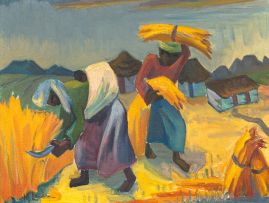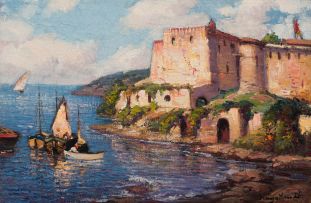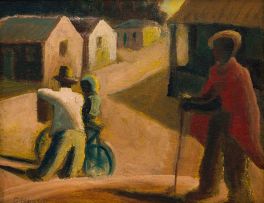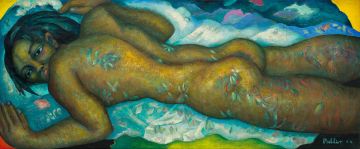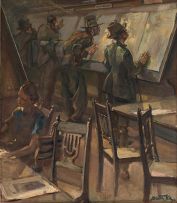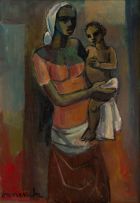Important South African and International Art
Live Auction, 13 November 2017
Session Three
Incl. Buyer's Premium & VAT
About this Item
signed; inscribed with the title on a Johannesburg Art Gallery label adhered to the reverse
Notes
No fewer than two photographs in Maggie Lauber’s albums housed in the archives at the University of Stellenbosch attest to her interest in harvest scenes. One photo depicting a lone woman in a vast field, gathering sheaves of wheat, was the inspiration for one of her earliest harvest scenes from 1922. The other is a photograph of a harvest scene on the Grosswalding estate of Baron Hafenbrödl near Deggendorf, Germany. He was a friend of Arnold Balwé, son of Jan Balwé, a very close friend and champion of the young Laubser who was studying in England and in Europe at the time.
When Jan suddenly died in 1921, Laubser returned to the family farm at Oortmanspost in the Western Cape finding solace in painting which revived her strong affinity with nature. ‘In the dignity of labourers at their task, the meekness of animals, the ephemeral glory of flowers, in the fertile soil itself, she perceived an interdependence of all things’, maintains Johan van Rooyen.1
Dalene Marais’s Maggie Laubser: Her paintings, drawings and graphics records many harvest scenes from this period of the late-1920s and early 30s. In addition, Elza Botha’s Die Lewe en Skilderwerk van Maggie Laubser, her unpublished Master’s Dissertation at the University of Pretoria, records yet another batch of harvest scenes from the early 1960s, of which the present lot is a fine example. Van Rooyen emphasizes two aspects with regard to Laubser’s harvest scenes: the shift in her use of colour; and her strong sense of composition. The shift in colour, verified by Muller Ballot, is evident when comparing the sombre colours of her English and Scottish landscapes and the Belgian, German and Italian landscape of the late-1910s with the harvest scenes of the late-1920s. In the present lot, the yellows and greens of the wheat fields contrast with the purples and blues of the figures and, in turn, with the dark blue clouds in the background.
In terms of composition, Van Rooyen notices in an early harvest scene that the sheaves of wheat and the bent harvesters are arranged in a veritable circle, in clock-like fashion, symbolizing the cycle of life. The composition of the present work, however, is particularly interesting. ‘Anybody looking at any one of my pictures’, Laubser maintained, ‘will see how design is the fundamental basis of all – what is there is an intimate relationship between lines, curves, full and half-planes in my composition’.2 In this regard, the two curved figures illustrate Laubser’s strong sense of design: one figure curving towards the left, and the other, with the sheaves of wheat in her arms, towards the right. The left
and right curves are repeated in the two stacked sheaves, left in the foreground. In addition, the curve of the bent figure on the left is intersected with another curve in the shape of a baby tied to her back with a white blanket.
Although Laubser as a Calvinist never depicted overt or outspoken Christian themes, Van Rooyen maintains that the intensely religious overtones of this harvest landscape become obvious. He likens the reaping women with the biblical reference to Ruth, gleaning the fields of Boas for the last sheaves of corn. The parable of the Samaritan woman in which Jesus admonishes his disciples that there is work to be done, is pertinent in this regard: ‘Don’t you have a saying, “It’s still four months until harvest”? I tell you, open your eyes and look at the fields! They are ripe for harvest. Even now the one who reaps, draws a wage and harvests a crop for eternal life, so that the sower and the reaper may be glad together’ (John 4: 35–36). This particular harvest scene always hung to the left of the fireplace in Laubser’s sitting room in her house, Altyd Lig.
1 Anon. (1974) Maggie Laubser South African Art Library, page 12.
2 Muller Ballot. (2015) Maggie Laubser: ‘n Venster op Altyd Lig. Sun Press. See page 308.
Provenance
Mrs M Mentz, Harrismith
Mrs ML Fobian, Paarl
Mr G Relly, Johannesburg acquired through Mr E Loerincz, Johannesburg
Sotheby Parke Bernet South Africa (Pty) Ltd., Johannesburg, 22 October 1974, lot 341, illustrated on page 341
Exhibited
Johannesburg Art Gallery, 24 November 1980 to 4 January 1981, catalogue number 28, lent by Mrs J Relly
Literature
Dalene Marais. (1994) Maggie Laubser: her paintings, drawings and graphics, Johannesburg and Cape Town: Perskor. Illustrated on page 274, catalogue number 1062, with the title Two Harvesters in a Landscape with House in the Background.
